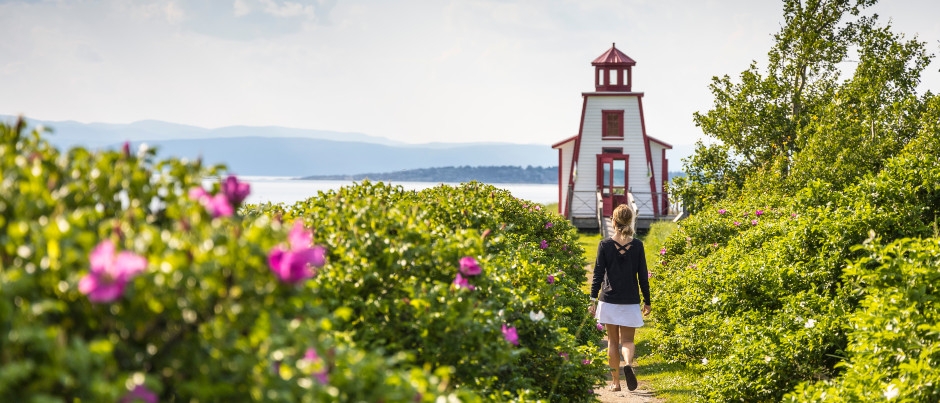The Québec maritime Blog

-
Saint-André-de-Kamouraska Lighthouse
Mathieu Dupuis
Discover the Scenic Attractions of the Kamouraska Area
Follow the Guide!
Ah, Kamouraska, how I adore you! Like so many who live elsewhere in Québec, I love this area of Bas-Saint-Laurent: just thinking about spending some time here conjures images of relaxation, contemplation, delicious food and evocative scents… A visit to this area is all about immersing yourself in a picturesque and pastoral setting, what the locals call le doux pays (“the sweet land”). Kamouraska is a charming combination of sea, gentle plain and scattered hills…
A mighty waterway

Although the St. Lawrence is fed by a few waterways almost as wide as it is, it’s the only river to cross Québec and is the soul of the province. Bas-Saint-Laurent residents call it “the river,” though at this level, it’s technically an estuary. This immense expanse of water is a daily part of their lives: they walk along its shores, sail on it, fish on the wharves—they even live in a region nicknamed the “Lower St. Lawrence.”
Algonquin people call it Magtogoek, “the path that walks.” It’s how the first European settlers arrived from France and then from Québec City. After transporting them, the St. Lawrence fed them. Here in Kamouraska, in the very part of the estuary where fresh water from the Great Lakes meets salt water flowing up from Labrador, this mighty waterway was full of eels, sturgeon, salmon and sardines. Today, the St. Lawrence is one of the most important shipping lanes in the world and is renowned for being difficult to navigate.
The estuary

You may think I’m bragging, but I swear this is true: the St. Lawrence is the largest estuary on the planet! From the villages of Kamouraska, the opposite shore is 15 km (9 mi.) away. (Near the mouth of the estuary, where it’s at its widest, it’s five times that.) This is just close enough to still see the Laurentian Mountains, the Québec portion of the Canadian Shield, on the horizon; on summer evenings, you can often watch the sun disappear behind them in a blaze of glorious colours. Baudelaire could have written his “Evening Harmony” here. Later on, if you insist, I’ll recite some of it to you…
A few dozen islands bathe in these same waters where flocks of seabirds come to nest in a quiet protected area, including beautiful eiders whose down is carefully harvested to keep us cozy and warm on cold winter nights, snuggled up under our duvets.
The coastal plain

The St. Lawrence Lowlands are one of the seven physiographic regions of Canada. Much like the north shore of the river has the Laurentian Mountains, the coastal plain to the south is at the foot of the Appalachians. The Kamouraska area is nestled at the heart of all this: 15 picturesque villages, farmers’ fields, grain silos, churches, heritage homes and monadnocks, all which are so typical of the Kamouraska plain.
“Monad-what?”

To me, the monadnocks are this area’s most distinctive feature. You’ll spot these rocky hills, which are about 30 metres (100 feet) high, dotted across the plain. The locals call them cabourons, the First Nations people named them monadnocks, and scientists know them as inselbergs: remnants of granite rock created by the erosion of the Appalachians. As seismic activities are frequent in the area, the churches and houses of Kamouraska’s first villages were built on the bedrock around the monadnocks, which protected them from the prevailing winds. Where you spot these rocky hills, you’ll likely see a village and steeple!
Kamouraska’s beautiful villages

Although they originated during the French regime, the seigneuries of Kamouraska really started to flourish after the British Conquest. The population during the first colonial regime was only about 1500 people, most of whom fished for eels and sturgeon, grew damson plums and hunted harbour porpoises, all of which were destined for markets in Québec City. Then the British arrived. To ensure the capture of Québec and the colony as a whole, the entire coast was burned on the eve of the decisive Battle of the Plains of Abraham.
With political stability came progress in the colony. And “progress” meant middle-class people in need of a vacation, and middle-class vacations meant summer holidays by the sea.

Kamouraska soon became a popular resort for the affluent classes of Québec City and Montréal. As a result, the area boasts many beautiful houses that blend so well into the surrounding scenery. At the time these buildings were constructed, the latest English architectural style, called the Picturesque movement, was to open buildings to nature. Traditional English cottages and larger Italian-style villas were therefore built with large verandas and French windows overlooking the gardens.

Over time, local communities have reclaimed these heritage buildings, turning many of them into businesses such as cozy inns, bakeries, chocolate shops and museums. Many are still just as charming on the inside where they exude an atmosphere of yesteryear.
Enjoying the countryside

Spend a few days with me in the Kamouraska area and you’ll find a wide variety of things to do: enjoy foodie adventures in the villages, relax on a beach (bring a picnic, go for a stroll or read a book), go paddle boarding on the sea, hike on the plateaus or explore the countryside at a leisurely pace along miles of the Route Verte cycling network where you can discover old barns, farm sheds, stables, gazebos, produce stands, dairies, bakehouses, old bread ovens and wayside crosses.

Next, why not set off on a guided sea kayaking excursion around the Kamouraska Islands at slack tide (the best time to go kayaking)? Keep an eye out for murres, razorbills and eiders as well as harbour seals along the shoreline. You’ll come back with photos of the open sea, the mudflats and rocky foreshore, beaches, marshes and pretty riverside homes.

Once you’re back, I’ll take you to the villages on the plateaus where you’ll find magnificent spots to observe the immensity of the plain. It’ll soon be time for drinks at sunset, and yes, I may be persuaded to recite some Baudelaire* for you:
And sounds and scents in the vesper breezes turn;
A melancholy waltz — and a drowsiness divine.
…
The sunset drowns within its blood-red brine.
By the way, have you ever seen a flax field in bloom? I haven’t yet, but I’m sure they’re magnificent, their bluish-purple flowers reminiscent of lavender minus the scent, but then you can breathe in the salty sea air…
Enjoy discovering the Kamouraska area!
*From “Evening Harmony” by Charles Baudelaire, translated by Cyril Scott in Baudelaire: The Flowers of Evil, London: Elkin Mathews, 1909 (https://fleursdumal.org/poem/142).

(0) comment